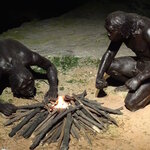Anthropology

Though women are the majority in the life sciences and men might need outreach programs to counteract potential bias against them in the social sciences, in math-intensive fields like physics women still lag.
Sociologists believe that it may be due to misperception; that you either have math ability or you don't. Counter that misperception and you the problem is solved.
Math is a language. While some people have more aptitude for languages, clearly everyone can learn both. Framing math that way, that it is an ability that can be developed, rather than binary, would help women, say Lara Perez-…

Amateur cook-offs like the hugely popular MasterChef series now in its seventh season in Australia have been part of our TV diet for almost two decades.
These shows celebrate the remarkable lengths we humans will go to to whet the appetite, stimulate the senses, fire our neural reward systems and sustain the body.
Yet, few of us pause to reflect on the hugely important role diet plays in the ecology and evolutionary history of all species, including our own.
In the latest episode of my UNSWTV video series ‘How did we get here?’, I take a light hearted look at the role diet has played in our…

Lethal wounds identified on a human skull may indicate one of the first cases of murder in human history, according to a new paper.
The archaeological site, Sima de los Huesos in northern Spain, is located deep within an underground cave system and contains the skeletal remains of at least 28 individuals that date to around 430,000 years ago, during the Middle Pleistocene. The only access to the site is through a 13-meter deep vertical shaft, and how the human bodies arrived there remains a mystery.
A nearly complete skull, Cranium 17 from the Sima de los Huesos, is comprised of 52 cranial…

The Red Lady burial site in El Mirón cave, outside Ramales de la Victoria in Cantabria, Spain, dates back to the Upper Palaeolithic 16,000 years ago. The archaeological site was discovered in 1903 but it wasn't until 2010 that bones were discovered at the back of the cave, in a small space between the wall and a fallen block. Both the bones and the sediment under them were reddish.
The remains turned out to be of a woman, between 35 and 40 years of age, and because of the color the Red Lady mystery was born. The reddish color means the use of ochre and ochre has been linked to religious…
Acoustics would seem to be primarily science - make sure sound waves are not piling up on each other in strange places and that everyone can hear what they are supposed to hear - but a new study says it is not so objective and the response of audiences and performers to acoustic characteristics is a function of their worldview, according to archaeo-acoustician Steven J. Waller at the 169th meeting of the Acoustical Society of America in Pittsburgh.
"It's a parallel to 'beauty is in the eye of the beholder': perfect performance spaces are really in the ear of the listener. Today we value…

A new genomic analysis of an ancient Taimyr wolf bone reveals that dogs and humans may have been a match far longer than previously believed.
Earlier genome-based estimates have suggested that the ancestors of modern-day dogs diverged from wolves no more than 16,000 years ago, after the last Ice Age, but new 35,000 year-old radiocarbon dating shows the Taimyr wolf represents the most recent common ancestor of modern wolves and dogs.
The researchers made these discoveries based on a small piece of bone picked up during an expedition to the Taimyr Peninsula in Siberia. Initially, they…

Males rule in most of the animal world. But when it comes to conventional gender roles, lemurs -- distant primate cousins of ours -- buck the trend. Lemur girls behave more like boys, thanks to a little testosterone.
Most female mammals that get their way over males are well-armed to be the bullies - dominant female spotted hyenas are bigger and heavier than males - but female lemurs are no bigger than males, and they don't have antlers or bigger fangs to give them a physical edge over their mates. Yet they still bite mates, snatch fruit from their hands, whack them in the head or shove them…

We may think that not wanting to live around relatives is a modern trait, but our closest anthropological relatives, modern day hunter-gatherers, choose to not live among family members as much as we think. That goes for when males and females have the choice.
Hunter-gatherer populations have large numbers of unrelated individuals but it seems like they live with kin. Do couples always move? M. Dyble and colleagues developed a model of behavior to study it - running two versions, one where both the husband and wife in a hunter-gatherer couple could have equal influence over where their…

“Birds of a feather flock together” is a saying that exists in a number of different languages. “Gambá cheira gambá” (opossums smell other opossums) in Brazilian Portuguese is a particularly colorful example.
The reason is that like-minded people like to hang out together across many cultures. And it seems the same is true of baboons.
Baboons' preference to spend time with similar personality types was revealed in a study of wild chacma baboons in Namibia. It found that the monkeys typically associate with other baboons based on personality type, age, rank and propensity to generate or use…

"It takes a village to raise a child" is folk wisdom which means that quality communities turn out quality individuals.
It may have seemed like a new idea when First Lady Hillary Clinton said it in the 1990s but ancient societies formed cooperative groups to help raise their children. Why did that happen?
University of Utah anthropologist Karen Kramer and colleagues created an economic model where mothers had one dependent offspring at a time, ended support of their young at weaning and received no help from others and then mapped it to where mothers often have multiple kids…